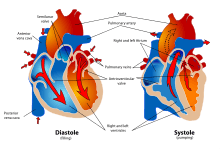Definify.com
Webster 1913 Edition
Diastole
‖
Di-as′to-le
,Noun.
[L., fr. Gr. [GREEK], fr. [GREEK] to put asunder, to separate;
διά
through + [GREEK] to set, to place.] 1.
(Physiol.)
The rhythmical expansion or dilatation of the heart and arteries; – correlative to
systole
, or contraction. 2.
(Gram.)
A figure by which a syllable naturally short is made long.
Webster 1828 Edition
Diastole
DIASTOLE
, DIASTOLY,Noun.
1.
Among physicians, a dilation of the heart, auricles and arteries; opposed to systole or contraction.2.
In grammar, the extension of a syllable; or a figure by which a syllable naturally short is made long.Definition 2025
Diastole
Diastole
German
Noun
Diastole f (genitive Diastole, plural Diastolen)
Declension
Declension of Diastole
Antonyms
diastole
diastole
English

The diastole (filling) and systole (pumping) processes of a healthy human heart
Noun
diastole (usually uncountable, plural diastoles)
- (chiefly uncountable, physiology) The phase or process of relaxation and dilation of the heart chambers, between contractions, during which they fill with blood; an instance of the process.
- 2005, Richard H. Vagelos, Rachel Marcus, J. Edwin Atwood, 35: Signs, Symptoms, and Laboratory Abnormalities in Cardiovascular Diseases, Robert M. Wachter, Lee Goldman, Harry Hollander (editors), Hospital Medicine, 2nd Edition, page 309,
- In patients with rapid rates, diastole may be sufficiently shortened that the third and fourth heart sounds become superimposed and form a summation gallop.
- 2008, Jack H. Wilmore, David L. Costill, W. Larry Kenney, Physiology of Sport and Exercise, page 132,
- Of the total cardiac cycle at this rate, diastole accounts for 0.50 s, or 62% of the cycle, and systole accounts for 0.31 s, or 38%.
- 2011, Julian Maizel, Michel Slama, 9: Hermodynamic Evaluation in the Patient with Arrhythmias, Daniel de Backer, Bernard P. Cholley, Michel Slama, Antoine Vieillard-Baron, Philippe Vignon (editors), Hemodynamic Monitoring Using Echocardiography in the Critically Ill, Springer, page 90,
- During a short cycle or premature contraction, LV ejection begins before pressure in the aorta has completely decreased, and it remains higher than with longer diastoles [4, 5].
- 2005, Richard H. Vagelos, Rachel Marcus, J. Edwin Atwood, 35: Signs, Symptoms, and Laboratory Abnormalities in Cardiovascular Diseases, Robert M. Wachter, Lee Goldman, Harry Hollander (editors), Hospital Medicine, 2nd Edition, page 309,
- (uncountable, prosody) The lengthening of a vowel or syllable beyond its typical length.
- 1815 March and June, On the Greek and Latin Accents, The Classical Journal, Volume XI, page 81,
- I have inserted diastole which is omitted in Putschius, an insertion which both the complement, and the subsequent text make necessary.
- 1841, Gottfried Weber, Godfrey Weber′s General Music Teacher, page 115,
- […] according to prosody, this syllable has the diastole and the stress, whereas the second of “cujus” or of “animam” has not.
- 2010, Jürgen Thym, Ann Clark Fehn, Of Poetry and Song: Approaches to the Nineteenth-Century Lied, page 46,
- Surely Goethe′s basic dichotomy of systole and diastole in the Divan poem […] .
- 1815 March and June, On the Greek and Latin Accents, The Classical Journal, Volume XI, page 81,
- (Greek grammar) The hypodiastole, a textual or punctuation mark formerly used to disambiguate homonyms in Greek.
Synonyms
- (prosody): ectasis
Antonyms
Derived terms
See also
- (prosody): caesura, synaeresis, synecphonesis, synizesis
Translations
relaxation of the heart
Anagrams
Dutch
Pronunciation
- IPA(key): /di.aː.ˈstoː.lə/
Etymology
From Ancient Greek διαστολή (diastolḗ, “separation, drawing asunder”).
Noun
diastole f (plural diastoles)
Antonyms
French
Etymology
From Ancient Greek διαστολή (diastolḗ, “separation, drawing asunder”).
Pronunciation
- IPA(key): /djastɔl/
Noun
diastole f (plural diastoles)
Derived terms
Antonyms
Anagrams
Italian
Etymology
From Ancient Greek διαστολή (diastolḗ, “separation, drawing asunder”).
Pronunciation
- IPA(key): /diˈastole/, [d̪i.ˈaː.st̪o.le]
- Hyphenation: di‧à‧sto‧le
Noun
diastole f (plural diastoli)